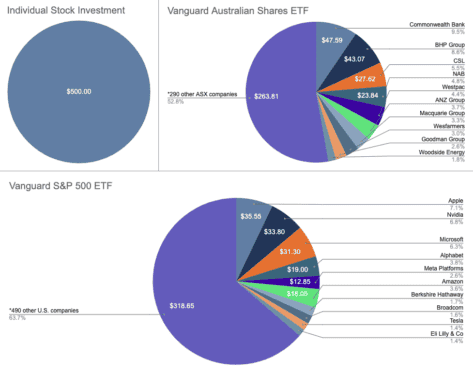Making your first ASX investment can be the most daunting step in the compounding journey. It's not too dissimilar from our debut on a bicycle or our first day of school — so many butterflies in the belly you'd think it's a conservatory. Except, investing turns the emotion dial another click clockwise by involving money.
For many Australians, a mental barrier stands between them and long-term wealth creation. The usual outcome is the 'investing thing' goes in the too-hard basket for another year.
There's a real cost to doing this.
In 2024, it's the missed 10% return from the S&P/ASX 200 Index (ASX: XJO) before dividends; or the forgone 28% from the S&P 500 Index (SP: .INX). But even then, the market can be too overwhelming to tackle despite the fruits it can bear.
Only this weekend was I reminded of this proverbial wall when I was at my local optometrist. After helping me pick out a new set of specs, a friendly man named Nick asked what I do for work. Long story short, he shared a desire to start investing but hadn't taken the plunge yet for a few reasons.
The usual suspects: how to know what's a good investment, what broker to use, etc.
One reason caught my attention. It's a completely valid reason, but I also think it's an entirely solvable one.
'All-in' ASX investment hurdle
Nick made a great point, which took me down memory lane of the first investment I ever made.
Part of Nick's challenge in getting started, and I'm paraphrasing here, was, "If you make your first investment and then it falls 10% or 20%, that's scary!" To which I replied, "Yes, that's definitely true! Especially when you're first starting out with $500, which can be a fair chunk of all the money available to you".
In other words, your first ASX investment can feel high stakes because you're 'all-in' on one company from day one. Now, I'll only speak for myself; my investing prowess was fairly minimal on my first attempt. But that's the norm when trying anything for the first time.
For many, the chance of a $500 investment going bad is too great a mental hurdle to overcome. If I had to guess, that's possibly the big reason Nick and countless other Australians are still staying out of the share market.
But it doesn't need to be this way.
See, the anxiousness here probably comes down to volatility. Big and sudden moves in the value of our money can put more knots in a stomach than a ball of string. We're not biologically programmed to see such choppiness and be emotionless.
Welcome to the rock pool
When I was young, I loved splashing around in the rock pool on Shelly Beach, Ballina, during a family vacation. It meant enjoying the ocean without the thumping waves or the risk of getting washed away.
In a way, index-tracking exchange-traded funds (ETF) are the rock pool of the share market.
The waters are generally calmer; you still get to embrace the perks of investing, and even when a big wave strikes, it will probably be softened through diversification.

The pie charts above illustrate the protection afforded by an ETF. For example, a $500 investment in the Vanguard Australian Shares Index ETF (ASX: VAS) would instantly be dispersed across 300 companies, including:
- $47 in Commonwealth Bank of Australia (ASX: CBA)
- $43 in BHP Group Ltd (ASX: BHP)
- $27 in CSL Ltd (ASX: CSL)
- $263 spread across around 290 other ASX companies
Or, if we wanted to focus on the biggest companies in the United States, a $500 investment in the Vanguard S&P 500 ETF (NYSE: VOO) would be immediately diversified across 500 companies, including:
- $35 in Apple Inc (NASDAQ: AAPL)
- $33 in Nvidia Corp (NASDAQ: NVDA)
- $31 in Microsoft Corp (NASDAQ: MSFT)
- $318 spread across around 490 other U.S. companies
Alternatively, the iShares S&P 500 AUD ETF (ASX: IVV) is an ASX-listed investment that also tracks the top 500 US companies.
Like the training wheels of a bicycle or a parent's hand on our first day of school, an ETF can be the safety net we lean on before we build up enough experience and courage to find our feet.









